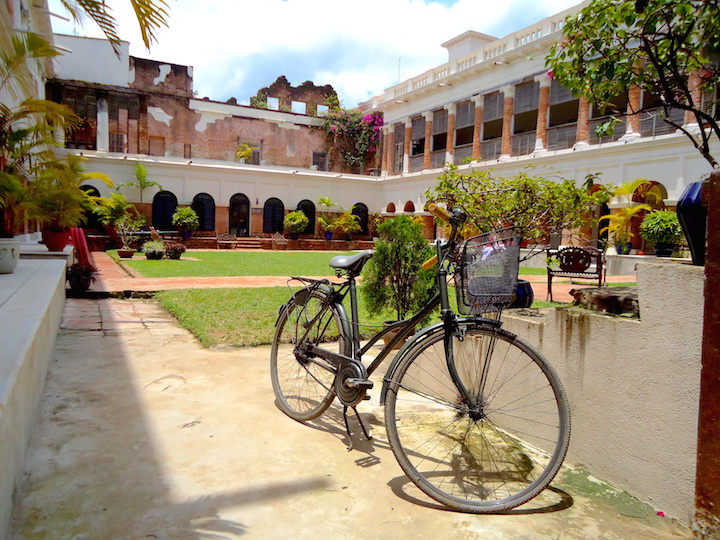I drove a short 40 kilometres away from Kolkata, towards Joka, into the rustic Bengal villages. The narrow roads lined with coconut trees, the chaotic market junctions and clear ponds made the drive scenic. My destination was the 265-year old Rajbari Bawali.
Rajbari or palatial homes of Zamindars have been a part of Bengal’s history. One such rajbari has been restored in the village of Bawali, which is now a boutique hotel. The name ‘Bawali’ can be traced to its first settlers, Baule. This big village flourishes with life and small businesses. The rajbari was gifted by the British to Uday Narayan Mondol, whose lineage continues to live here. This has withstood the test of time, unlike others in the area.
I entered Rajbari Bawali an hour before dusk and was briefly introduced to Samar Mondol, a descendant of the original Mondol family. Every evening’s aarti is conducted by him, where all guests are invited. However, I had other plans.



I left the heritage property to explore the village of Bawali. It is inhabited by approximately 300 families. I witnessed typical evening activities—people walking back home, socialising with their neighbours or doing the ritualistic evening puja.
My walk begun with a 324-year old Radha Krishna temple. An arched alley made of red bricks and pillars with Victorian flower motifs led me to the main temple. After a short flight of stairs, I peeked at the idols inside. The dome of the temple stood out. With a few terracotta etchings outside with moss and plants growing out which added texture to it.




I continued along the narrow lanes of the village—flanked by small, colourful houses, swampland and ponds every few metres. I reached the dilapidated structure, Jaltuni Bagan, which was the sight where the kings would spectate music and dance performances. On the banks of the pond was an open structure for the audience (still accessible) and within the pond, an elevated one connected by a collapse iron bridge.
The following day, I was excited to explore the contemporary Bawali. I hired an auto-rickshaw and went to Burul Ghat by River Hoogly. Only 11 kilometres away from Rajbari Bawali, I met fishermen who caught small shrimps during the low tide.


On my way back, I stopped at Nodakhali to meet Uttam Jana, an idol maker. He is 60 years old now and has been in the profession for 45 years. When I met him, he was swamped with upcoming Durga Puja orders. I walked around his workshop to admire the hard work with which they created the idols.
A few metres away, I halted at a workshop where craftsmen specialise in zari work. Here I met Saifuddin who is trained in this exceptional and intricate thread work. I enquired if there was a Mukaish piece available to buy but he was working only on commissioned orders.
In Rajbari Bawali, I refuelled with a traditional Bengali meal. In fact, I was preparing for the next activity: a treatment at their in-house spa, Mantra. After a humid exploration of locale, I finally rewarded myself.



On my way out of the spa, I observed the architecture of this rajbari. Surrounded by two floors of guest rooms, the brick work has been carefully restored. The patches of exposed bricks seemed like evidence of its historic past. On its south side, a mossed wall, broken arches and an open verandah have remained untouched. And on the opposite, I saw Samar Mondol making an appearance to perform the customary evening aarti. The 74-year old resident stood on the stairs leading to the colonial restaurant, with incense sticks, dhak or drum, sacred lamp and the conch bearer on either sides.
The following morning, I peddled away towards the main town. Amidst all the chaos, I took an unknown turn and stopped by a large pond. Beyond coconut trees, I saw the dome of the temple near Rajbari Bawali.
I knew I had to make my way back, away from Bawali.




Practical information
Distance: Approx 40 kilometres from Kolkata
Time: Approx 1.5 hours
Route: Drive towards Joka on Thakurpukur Road. Continue on Thakurpukur-Bibirhat-Bakhrahat-Raipur Road to turn right on KP Mondal Road. Drive until Bawali High School.
Stay: The Rajbari Bawali, www.therajbari.com. Tariffs vary according to season and plans.
Travel tips:
-Auto rickshaws are the most preferred mode of transport within the town.
-The Rajbari Bawali organises boat rides on River Hooghly and cycle excursions around the village seasonally.
-Since Bawali has many ponds, mosquitoes are plenty. Carry a mosquito repellent while travelling.
Read: Staying at The Anvaya Beach Resort, Bali
Have you experienced a rustic Bengal village yet?
I travelled to Bawali in the summer of 2017. An edited version of this story was published in Mint.
To see more photos from my journeys Like my Facebook Page and follow me on Instagram.






